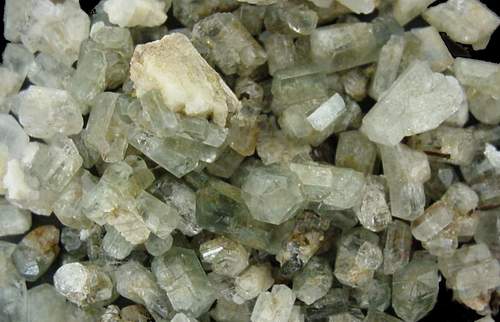Oxford County, Maine
Coromoto Minerals
The 1998 Season at the Orchard
Pit
"phenakite pocket"

Some of the phenakites found in '98
Coromoto Minerals
The 1998 Season at the Orchard
Pit
"phenakite pocket"

Some of the phenakites found in '98
| Continued from the '98 golden beryl:
The afternoon was spent chasing the golden beryl pocket. Once we had
exhausted the beryl pocket, we started closely examining the surrounding
exposed pegmatite. Doug Smith whose mantra is 'oxidized zones', starting Over 500 crystals in sizes from 1mm to over 2 cm were taken from the
seam. Most of the crystals were euhedral although a few were found on matrix
or tangled into mats.. For thet rest of the next few weeks we continued working back towards
the headwall of the pit. We encountered many quartz pods filled with blue
and green beryl. Occasionally in a feldspar cavity, a small pocket beryl
would |
In the loading picture the pegmatite margins can be clearly seen behind the excavtor. The headwall at this point is marked by large microcline crystals, quartz pods and fabundant blue beryl of intense color. Notice how the country rock appears to wrap over the top of the vein. As we progressed farther up the strike, this hood was to become thicker and at first be the cause of some discouragement. Mining is truly 99% perspiration. Add to that percentage 40% frustration and the 2% spent looking and you begin to get the idea of a day 'at the mine'. The math isn't right but I'd bet on those percnetages. It was mandatoy that each day include some kind of equipment crisis. Fortunately for us, the company doing our blasting was Ryan Rock. Tom Ryan, the owner, was to become an integral part of our operation providing not only the blasting but advice on every aspect of the operation. Tom had mined at the BB#7 in Greenwood, Maine for years. Tom did not spare us his observations and evaluation and soon got us pointed in a more practical direction. In addition he had a tool or fix-it for almost every situation. In the picture above, Tom has removed the tailgate from his truck we rented fearing that we would either rip it off with the excavator or forget to open it when dumping and roll the truck down the banking. We in fact did those things and more during the first part of our traing phase. There is no doubt... mining is dangerous. As we continued to work it soon became clear that Doug was developing skills at operating the excavator and my role was to the odd jobs fix-it guy. That is when we weren't drilling holes, pumping out the pit, hauling tools or just plain shoveling rock. The next chapter in 1998: |